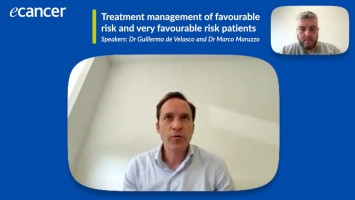Thanks for joining us on ecancer.tv. Can you tell me, what is the clinical context of this work, this very interesting work, you’ve been doing with a new agent? What was the problem clinically?
The problem is that chemotherapy induced nausea and vomiting remains a big problem because it affects the quality of life of the patients and it affects complaints to the treatment that we give the patients.
So tell me about this new compound because there are anti-nausea drugs already, aren’t there?
You have different classes: you have the corticosteroids, you have the 5-HT3 receptor antagonists and you have the NK1 receptor antagonists and they’ve been in the market for quite a while. What is good about this compound is that it’s a convenient compound to give once a day and it covers through the whole cycle because it has a long half-life. It also looks like it’s more effective on doing the receptor binding; it covers up to five days which I think is important also. In addition to that, the drug is not an inducer of CYP-3A4, because some of the other compounds are metabolised by that pathway. So therefore you don’t have drug-drug interactions like you potentially have with the other compounds.
So there are potential advantages with rolapitant but you randomised, you gave patients standard treatment plus or minus this new agent, didn’t you? What exactly did you do in this protocol?
In this protocol we gave patients… to qualify they had to get 60mg/m2 of cisplatin as a highly emetogenic chemotherapy, with other agents it could be used. So anywhere like treating lung cancer patients, or head and neck or whatever, when you give the patients cisplatin based therapy at 60 mg/m2 and then you randomise them to get a 5-HT3 receptor antagonist, in this case we used Granisetron at a dose of 0.01mg/kg, with dexamethasone on day one at a dose of 20mg and then you carry on day two, three and four, either randomised to placebo or to the rolapitant at a dose of 200mg once.
How many patients did you have?
We had 500 patients.
A big study then, what did you find?
We found that the patients that were treated on the triple therapy arm did a lot better compared to the two drugs. The primary endpoint was met on the study which was looking at vomiting at 24-120 hours, that was the primary endpoint. The other secondary endpoints were also significant, looking at basically overall control, no risk medication, total control of emesis and all the parameters were positive.
And could you give me some of the data, in very rough figures, of how much better it was than placebo?
There was an absolute gain at least of 10% in terms of the control with a significant p-value. When you look at the Kaplan–Meier curve the two curves start to split after twelve hours on time to emesis or time to rescue medication and then they plateau on the patients getting rolapitant as opposed to the patients getting Granisetron, corticosteroids and placebo that the curve kept on dropping and overall it didn’t plateau, it kept on dropping also.
You are, of course, adding a further agent so what about toxicity?
The toxicity wasn’t significantly… First of all, in all the categories on toxicity, like constipation and anorexia, was present in maximum of 7% of the patients. When you look at the data it was not significantly different to the control arm and when you discuss the particular side effects with the investigators, that they have to fill out a form and discuss what the likelihood was, it was more related to the chemotherapy drugs, so the cancer itself, and not to the rolapitant as located in the toxicity on the drug.
So what are the clinical implications coming out of this?
The clinical implications are that this is a good compound, that it has advantages over the other compounds. Now we cannot comment exactly if it’s better than the existing ones because we have to do a head-to-head comparison which I’m not sure if it’s going to happen one day. But from the point of view of the convenience it’s a much more convenient product because compounds like, for example, aprepitant you have to use it orally on days one, two and three; this one you use it on day one and also it looks pharmacokinetically superior to the aprepitant.
So what do you think clinicians should make of these data right now?
They should be cognisant the drug was fine for a new drug application with the FDA and then to be aware that the drug is going to be probably licensed soon. Basically when it’s commercially available probably they will use it for specific patients, for highly emetogenic chemotherapy. It’s also data very interesting on patients with breast cancer getting the AC type of chemotherapy, that is quite significant also.
So how would you sum up the brief bottom line message coming out of this?
That it’s a very positive trial, in my opinion it’s a very true study.
And how much of a difference do you think it could potentially make in managing chemotherapy related side effects in cancer?
I think it can make a big difference because you need to control this nausea and vomiting very well because if you don’t control it the patients are not complying with the cancer treatment itself. Some people fear having CIMV, or chemotherapy induced nausea and vomiting, on the next cycle of treatment and therefore they don’t come for treatment or they demand the doctor use lower doses to avoid it or things like that. Then also people get admitted to the wards because they have severe nausea and vomiting, they have electrolyte imbalance, some people develop renal failure, so I think it’s important to know how to control this.
Dr Rapoport, thank you very much indeed.
Thank you.








